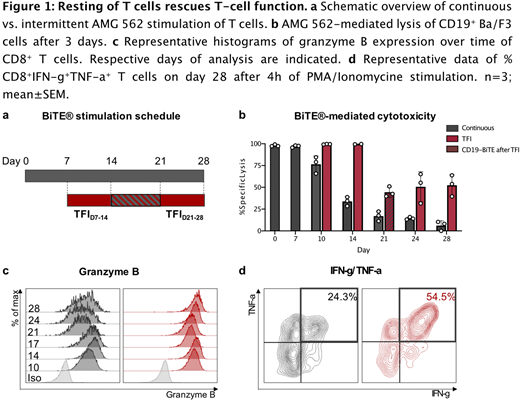The bispecific T-cell engager (BiTE®) blinatumomab is approved for treatment of relapsed/refractory B-cell precursor acute lymphoblastic leukemia and applied as continuous infusion over 28 days. The overall response rate to blinatumomab reported in clinical trials was 43 % and correlated to T-cell expansion (Zugmaier et al. 2015). In chronic viral infections, continuous antigen stimulation induces T-cell exhaustion, defined by phenotypic changes and functional impairment (Wherry 2011). Thus, we hypothesized that continuous BiTE® construct stimulation leads to T-cell exhaustion and that a treatment-free interval (TFI) reverses progressive T-cell dysfunction.
To simulate continuous application of a BiTE® construct in vitro, T-cell long-term co-cultures were set up. Healthy donor T cells were stimulated in the presence of CD19+ OCI-Ly1 cells for 28 days with AMG 562, a half-life extended CD19 and CD3 specific BiTE® construct. T cells were harvested from the co-culture every 3-4 days between day 7 and 28 and assessed for markers of T-cell exhaustion: (1) AMG 562-mediated cytotoxicity of T cells was evaluated as specific lysis of CD19+ Ba/F3 target cells after 3 days, (2) T-cell expansion during the cytotoxicity assay was calculated as fold change (FC) of CD2+ counts, (3) Cytokine secretion of AMG 562-stimulated T cells was evaluated in co-culture supernatants by cytometric bead array (CBA) or after PMA/Ionomycine stimulation via intracellular cytokine staining (ICCS), (4) T-cell metabolic fitness was determined by Mito- and Glycolytic Stress Test using a Seahorse Analyzer, and (5) expression of the exhaustion-related transcription factor TOX was assessed by multiparameter flow cytometry. In order to assess the effect of a TFI on T-cell function, we cultured T cells and CD19+ OCI-Ly1 cells in the absence of AMG 562 from day 7-14 and 21-28 and compared their activity to T cells stimulated continuously with AMG 562.
On day 7 of continuous (CONT) AMG 562 stimulation, we observed high cytotoxic and proliferative potential (% specific lysis=93±0.2, FC=2.9±0.2) as well as high IFN-g and TNF-a secretion analyzed by ICCS (% CD8+IFN-g+TNF-a+=23±6.7). However, cytotoxicity and proliferation decreased gradually until day 28 (% specific lysis=28±8.9; FC=0.6±0.1). CBA analysis confirmed decreasing secretion of IFN-g (day 3: 61113±12482, day 24: 3085±1351 pg/ml) and TNF-a (day 3: 1160±567, day 24: 43±7.6 pg/ml) as well as decreased IL-2 and granzyme B levels in culture supernatants. We furthermore observed highest mitochondrial fitness and basal glycolysis in T cells on day 7 of stimulation (basal OCR=2.2±0.6, maximal OCR=3.7±1.0, SRC=1.5±1.1 pmol/min/1000 cells, basal ECAR=2.0±0.4 mpH/min/1000 cells) which decreased until day 28 (basal OCR=0.4±0.2, maximal OCR=1.5±0.5, SRC=1.0±0.2 pmol/min/1000 cells, basal ECAR=0.5±0.2 mpH/min/1000 cells). In concordance, TOX increased during continuous stimulation (MFI ratio CD8+ day 7=6±0.8 to 12±0.8 on day 28).
Strikingly, implementation of a TFI of 7 days led to superior cytotoxicity in T cells compared to continuously stimulated T cells (% specific lysis on day 14 CONT=34±4.2, TFI=99±2.2) and granzyme B production (CD8+; MFI ratio on day 14 CONT=124±11, TFI=303±34). Furthermore, increased proliferation during the cytotoxicity assay was observed in previously rested T cells (FC CONT=0.2±0.0, TFI=1.6±0.6). Although T cell function also decreased over time in TFI T cells, they maintained a strikingly higher cytotoxic potential (CONT=6±4.4, TFI=52±9.9) as well as higher granzyme B production (CONT=25±2, TFI=170±11) on day 28 compared to continuously stimulated T cells. In addition, TFI T cells showed increased IFN-g and TNF-a secretion after PMA/Ionomycine stimulation on day 28 (% CD8+IFN-g+TNF-a+ CONT=21±3.8, TFI=38±11.6).
Our in vitro results demonstrate that continuous AMG 562 exposure negatively impacts T-cell function. Comprehensive analysis of T-cell activity in an array of functional assays suggests that continuous BiTE® construct exposure leads to T-cell exhaustion which can be mitigated through TFI. Currently, T cells from patients receiving blinatumomab are being analyzed to confirm the clinical relevance of our findings. Furthermore, RNA-Seq of continuously vs. intermittently AMG 562-exposed T cells will help us to understand underlying transcriptional mechanisms of BiTE® construct induced T-cell exhaustion.
Zieger:AMGEN Research Munich: Research Funding. Buecklein:Pfizer: Consultancy; Novartis: Research Funding; Celgene: Research Funding; Amgen: Consultancy; Gilead: Consultancy, Research Funding. Brauchle:AMGEN Inc.: Research Funding. Marcinek:AMGEN Research Munich: Research Funding. Kischel:AMGEN: Current Employment, Current equity holder in publicly-traded company, Patents & Royalties. Subklewe:Gilead Sciences: Consultancy, Honoraria, Research Funding; Pfizer: Consultancy, Honoraria; Morphosys: Research Funding; Seattle Genetics: Research Funding; AMGEN: Consultancy, Honoraria, Research Funding; Janssen: Consultancy; Roche AG: Consultancy, Research Funding; Novartis: Consultancy, Research Funding; Celgene: Consultancy, Honoraria.
Author notes
Asterisk with author names denotes non-ASH members.


This feature is available to Subscribers Only
Sign In or Create an Account Close Modal